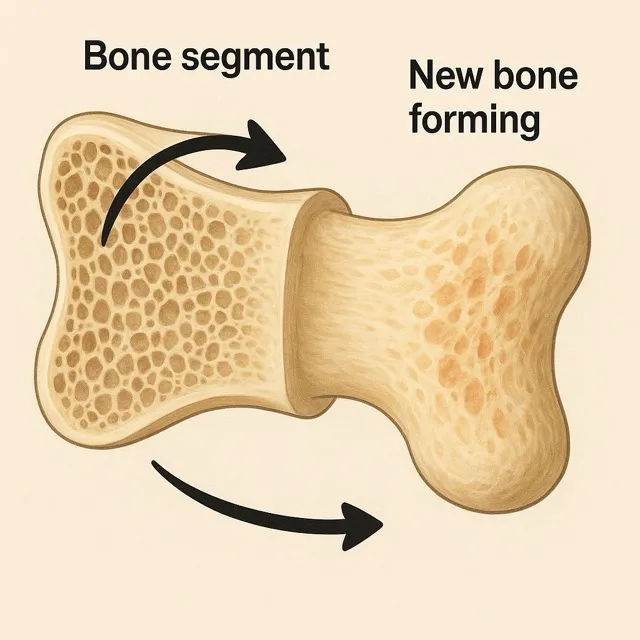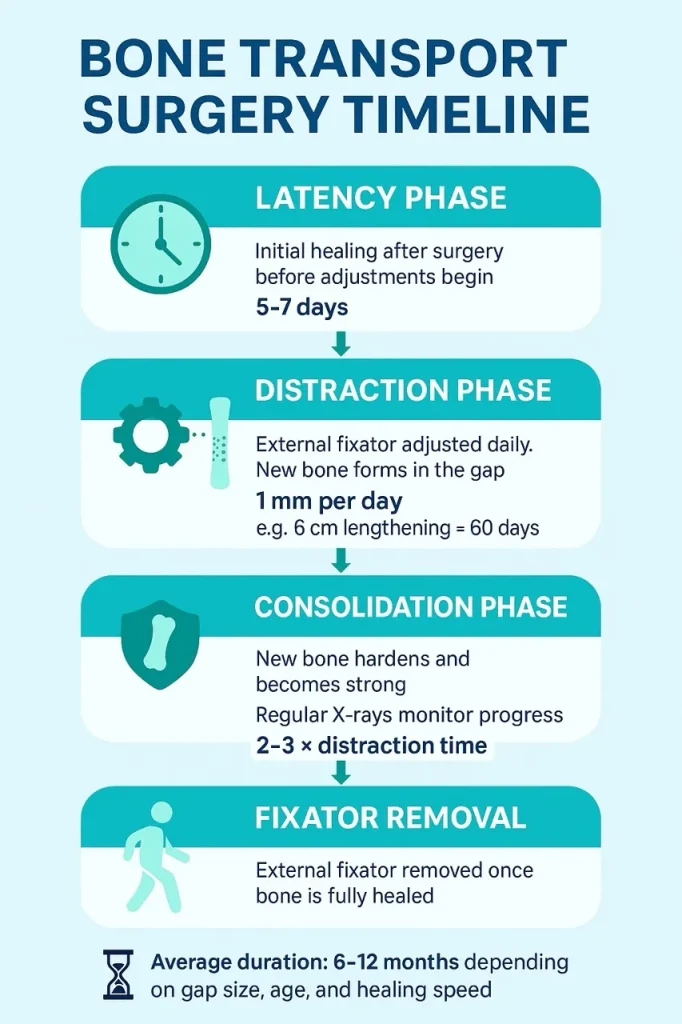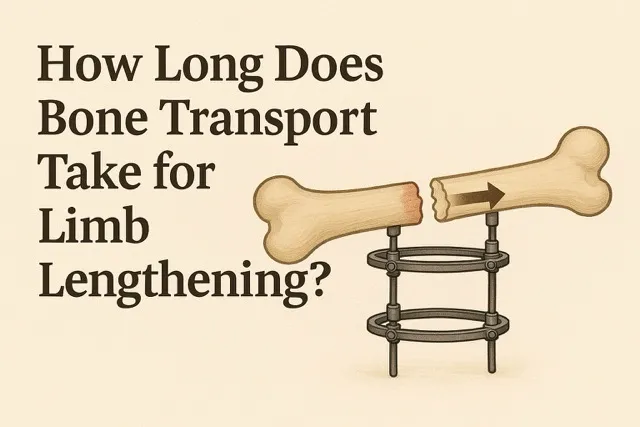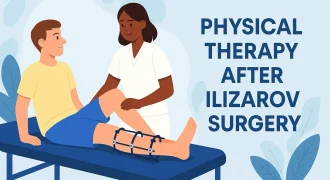Table of Contents
Why Time Matters in Bone Transport
Bone transport surgery is a proven technique to correct limb length discrepancies, bone defects, and deformities. While patients are reassured by its effectiveness, the most common question is:
👉 “ How long does bone transport take?”
The answer isn’t the same for everyone – it depends on the size of the bone gap, the patient’s healing rate, and the type of fixator used. Let’s break it down step by step.
What is Bone Transport in Limb Lengthening?
Bone transport is a method in which a controlled cut is made in the bone, and with the help of an external fixator (such as an Ilizarov frame), the bone is gradually moved to close a gap or increase its length. Behind the moving bone, new bone forms naturally, eventually restoring both length and strength.

The Timeline of Bone Transport

1. Latency Phase (5–7 days)
- After surgery, there is a short rest period before movement begins.
- This allows initial healing and prepares the bone for gradual distraction.
2. Distraction Phase (1 mm per day)
- The bone is moved at a controlled speed, usually 1 mm per day.
- If a patient needs 6 cm of lengthening, it will take about 60 days just for transport.
3. Consolidation Phase (2–3 times distraction period)
- Once the bone has been moved into place, the new bone must harden.
- This can take 2–3 times longer than the distraction phase.
- Example: 6 cm distraction = 4–6 months of consolidation.
4. Fixator Removal
- When X-rays show the new bone is strong, the fixator is removed.
- The patient may use braces or crutches for some weeks after removal.
So, How Long Does It Really Take?
On average:
- Small gaps (3–4 cm): 4–6 months
- Medium gaps (5–8 cm): 6–10 months
- Large gaps (>10 cm): 12+ months
Every patient’s journey is unique. Children often heal faster, while adults may need more time.
👉 Learn more about the treatment here: Bone Transport Surgery
Recovery Beyond Time
- Physiotherapy: Essential throughout the process to keep joints flexible.
- Nutrition: A diet rich in protein, calcium, and vitamin D supports faster healing.
- Commitment: Daily fixator adjustments and regular follow-ups are critical to success.

Dr. Divya Ahuja’s Approach
With years of experience in Ilizarov and limb reconstruction techniques, Dr. Ahuja ensures patients have clear timelines, close monitoring, and personalized recovery plans. His focus is not just on bone healing but also on helping patients regain full function and confidence.
Conclusion: Patience Pays Off in Bone Transport
Bone transport for limb lengthening is not a quick fix – it’s a step-by-step process that can take several months. But the reward is worth it: strong, natural bone and restored limb length.
With guidance from Dr. Divya Ahuja, patients in Mumbai and Navi Mumbai receive world-class treatment and full support throughout their journey.
Our Clinical Locations
Tap a location to view timings, contact, and map.
Broadway Healthcare, Dadar East
Broadway Healthcare, Dadar East
Clinic Info
- 📍 Broadway Healthcare, Dadar East, Mumbai
- 🕒 Wednesdays · 10:00 AM – 12:00 NOON
- 📞 Appointments: +91 93213 17227
Sweet Clinics, Vashi, Navi Mumbai
Sweet Clinics, Vashi, Navi Mumbai
Clinic Info
- 📍 Sweet Clinics, Vashi, Navi Mumbai
- 🕒 Fridays · 10:00 AM – 12:00 NOON
- 📞 Appointments: +91 93213 17227
Heal Well Speciality Clinic, Thane West
Heal Well Speciality Clinic, Thane West
Clinic & OPD Info
- 📍 Heal Well Speciality Clinic, Thane West
- 🕒 Every Wednesday 10:00 AM – 11:00 AM
- 📞 Appointments: +91 81691 04438
Mangal Anand Hospital, Chembur Mumbai
Mangal Anand Hospital, Chembur Mumbai
Clinic & OPD Info
- 📍 Mangal Anand Hospital, Chembur Mumbai
- 🕒 Monday, Wednesday, Friday 03-07 PM, Thursday 06-07 PM, Free OPD Saturday 02-04 PM
- 📞 Appointments: +91 70212 18182
FAQs
How long does bone transport usually take?
It depends on the defect size. On average, 1 mm of transport is done per day, followed by a longer consolidation phase. A 6 cm lengthening can take 6–8 months in total.
Why does bone transport take so long?
Because the bone is moved gradually to allow new bone to form naturally. If done too fast, the new bone won’t have time to grow strong, increasing the risk of complications.
Is the process faster in children than adults?
Yes. Children’s bones regenerate more quickly, so both the distraction and consolidation phases are shorter. Adults usually take longer.
Can the bone grow faster than 1 mm per day?
In rare cases, doctors may increase to 1.5 mm per day, but going too fast risks weak bone formation. 1 mm per day is the safest and most reliable rate.
How painful is bone transport during limb lengthening?
Most patients feel mild discomfort during daily adjustments, but pain is well-controlled with medication. The body usually adapts within a few weeks.
What happens if the new bone doesn’t form properly?
If the regenerated bone is weak or thin, doctors may slow down the distraction or extend the consolidation period. In rare cases, bone grafting may be added.
Do patients need to stay in the hospital during the entire process?
No. After surgery, patients go home with the fixator and visit the clinic regularly for adjustments and X-rays. A hospital stay is usually only a few days.
Can patients walk with the fixator on?
Yes, most patients are encouraged to walk with partial weight-bearing soon after surgery. Walking actually helps bone formation and prevents stiffness.
Does everyone heal at the same speed?
No. Healing depends on age, nutrition, bone health, presence of infection, and patient commitment to physiotherapy.
Will the limb be as strong as normal after bone transport?
Yes. Once the new bone fully consolidates, it becomes as strong as natural bone, and patients usually return to normal activities, including sports.









